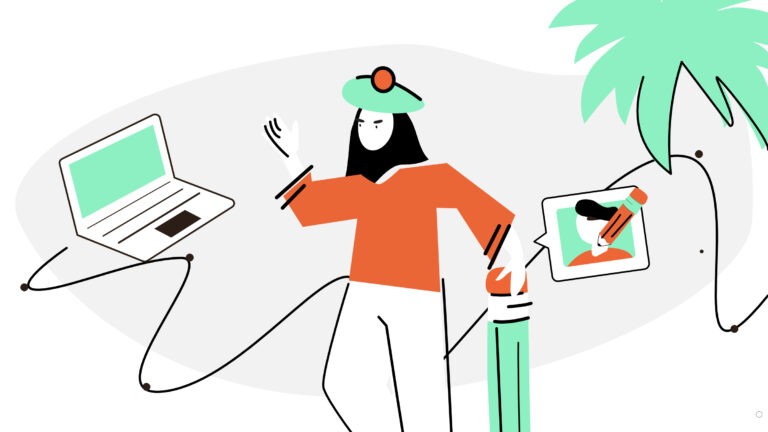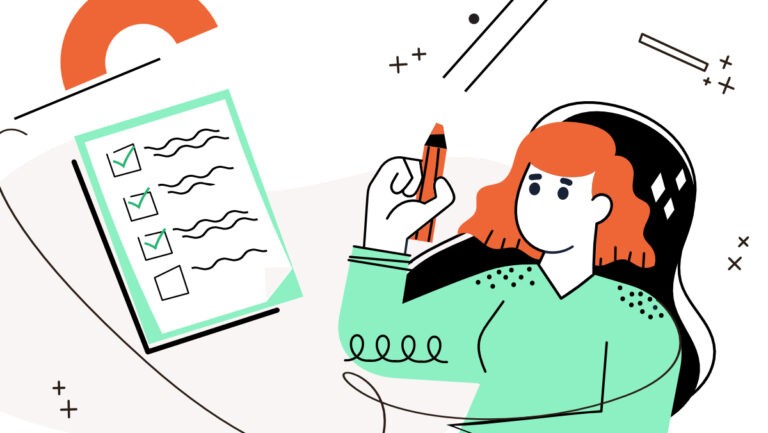Creating a brand design is crucial to the brand. The right design will engage people with your website more, find the right audience, will let customers know what parts of the content are more important than the others.
Design is a way to express the values of the brand, its message, and services – all this and more using a visual representation that will be processed by people in a matter of seconds.
It will help to create an emotional connection between the brand and a customer. Thought-through design’s capable of building strong associations in people’s minds: a designer that comprehends it creates successful stories for the clients they work with.
But who is that designer? By what qualities can we describe a good professional? What designer skills define that? We’ll show you 😉

Character Traits
Now, we’re not saying that you have to be a certain person to be a designer. But it is a lot simpler if you possess a set of personality traits we’re about to mention. In the end, you can nurture any of these features with a bit of conscious effort.
Curious
If you see an interesting design, do you look it up? Do you think of how the designer created this or that visual, what tools they used, and if you can do anything similar, or better?
Curiosity is a tool of itself, boosting professional growth, and the variability of the portfolio. It’s the curiosity that makes you use that specific element in your design. It’s all the “what if’s” that lead you to try out new things, styles, and ideas.
Responsible
This one’s no wonder. As a designer, you cannot do half the job and say ‘will do’. If we’re talking brand design specifically, you should understand that the overall result of the brand’s success will greatly depend on the visuals you produce.
Focused
Out of all designer skills, a great quality to have is being able to isolate themself from the world around and dive deep into the creative ‘zone’. Distractions don’t go well together with creativity, unfortunately it’s too timid and can run away too easily.
Meticulous
The Great designer looks for that simple brush stroke through every layer of the project. They nitpixel every inch of the design to make sure it’s just perfect.
You need to be attentive enough to notice a mistake if there is one and work on those small details required to make the design look polished.
Enthusiastic
Burning out is a curious issue. It’s hard to stay enthusiastic about every project you start working on, but it’s the only way you’ll put your best into your work.
Do not forget to rest and let your mind wander in other creative directions than your work. This will put your mind into a more relaxed state and welcome those timid creative thoughts to show up.
Soft skills
1. Communication is a key
You would think the first skill on the list would be something along the lines of being creative, but no. In our experience, the ability to communicate properly is much more important.
Designers communicate with clients throughout the creation process – from start to finish. You need to be able to get your ideas across, as well as your thoughts, vision, and opinions on the client’s suggestions.
The ability to choose the right tone, to be on the same wavelength as a client can simplify the cooperation; on the contrary, choosing the wrong words or not being able to discuss without getting too heated can lose you a client just like that.
☝🏻 Tip: you don’t want to use professional jargon while talking to a client. This won’t make you look any more professional, but will easily confuse your client. Remember, professionalism manifests itself in being able to explain specific things using popular, simple language.
If you want to improve this particular skill, try talking about design with people outside the field. Use simple words and see if they can understand what you’re talking about.
2. Flexibility
The pace of today’s world is just crazy – things change so fast. What’s popular today, won’t be tomorrow. As a designer, you should be quickly reacting to new trends and technologies.
You must be ready that every new project will be a challenge that you will need to find a solution for. If something goes wrong from the first try, don’t give up and keep thinking about possible solutions.
Being ‘flexible’ means to adapt to new situations without getting cornered and thinking that you’re no good.
To be more or less prepared and stay ‘design fit’, we recommend listening to podcasts, reading the news in the field, and staying informed about the latest trends in various design fields.
3. Ability to work in a team
However proficient and professional the designer is, you cannot build a good product alone. Be ready to work in a team and communicate with other designers, managers, developers, founders, and many more.
To create an appealing design, you will have to talk to developers to learn technical specifications and limitations. Marketing managers will tell you about the value of the product for customers.
Do not be shy to ask questions and work together with your team – the final result of the brand design will depend on your ability to communicate.
4. Empathy
Imagine yourself in your customer’s shoes. That’s the golden rule.
Try understanding what your customer needs, wants, and aims for. With your designs, cater to those needs, offer something that relieves pain, or helps find a solution to a problem.
You may want to offer different design solutions, created with different viewpoints in mind.
To know what pains the client, we recommend talking to them directly. Usability tests will help you understand what they like and dislike about the implemented design solution, and what brings them joy.
5. Passion for problem-solving
If you’ve chosen this career path, you should love problem-solving. That’s what the design – including brand design – is all about – finding solutions to the tasks you’re offered.
Sometimes it may take 100 takes to find the one result that’s just perfect. This means a lot of analyzing, sketching, thinking, and researching. It’s hard to do over and over again if you don’t like it. Possible? Yes. But if you do not have the will and passion for the process itself, you’ll burn out quickly.
Of course, you need to feed that passion sometimes. Look for inspiration, find some time between tasks to create visuals you personally like and challenge yourself constantly with shapes, colors, and styles.
6. Constructive Feedback
‘Make it pop’
‘Can you add more flair in it’
‘Jazz it up’
We bet you heard something like that a few times, haven’t you? This type of feedback is not especially helpful when designing something. As a designer, you need to take that and turn it into something that will help your client express what they want – even if they don’t know exactly what.
To do that, you need to explain the choices you made while working on the design.
‘I used these shapes, because..’
‘This color is best here, because..’
‘This particular design I used because it represents the values..’
..and ask the right questions.
‘Do you think this and that idea will work better representing our values?’
‘If you think the color palette doesn’t fit, would you go colder or warmer?’
‘Can you elaborate what you meant by..’
It’s always better to clarify with the client in what form you’d like to receive feedback before you start working on something. When presenting your visuals, you can ask not to interrupt and keep all suggestions until you finish, so that you could discuss them together more productively.
P.S. We’re collecting the phrases and ‘feedback’ designers just hate to receive – like the ones we mentioned in this section. Have some too? Send them to [email protected].
7. Active Listening
Related to the topic of receiving feedback, is the active listening of what you’re being told. Yes, the head of a designer is always full of ideas, especially when a client is describing what they want to see in a design.
But, stop for a moment. It’s important to listen to what they have to say and comprehend it. Discard all your thoughts and ideas for a quick second, and start to actively listen to what they have to say.
- They know the industry, probably better than you do.
- They know their audience, what they need and want better than you.
- They can provide you with an invaluable outside view of your works, a fresh perspective on what ideas to try out.
8. Open-Mindedness
Some ideas just don’t sit well and don’t seem worth investing our time into. However, this approach can be harmful: you can easily overlook creative and innovative solutions to the existing problems.
Try not to get stuck on the same answers just because they have always worked. Be a designer that is open-minded enough to consider solutions that don’t seem to work.
9. No ego
Humans like compliments – that’s our nature. Sometimes they are useful – a designer can become more confident in their ideas and visuals. However, developing a skill to look past the compliments and perceive negative feedback as areas for improvement is invaluable if you’re a designer.
If you’re only looking into what you’re doing great, you will develop arrogance and stop your progress dead in tracks. It’s important to not be personally insulted by criticism – if it’s constructive of course – try seeing it as a ladder, where each comment represents a step up.
10. Presenting skills
Developing designing skills, creating visuals, and keeping afloat with the latest trends is only half the battle. If you don’t know how to properly present what you’ve created, it’s trouble.
- When presenting your visuals, prepare key points, and make the discussion understandable. Don’t beat around the bush and make sure the client comprehends the ideas you’re putting out there.
- Illustrate the visuals with the thought process behind them; explain how they reflect the values of the brand and….
Use Gingersauce for presentation!
Gingersauce is a brand book builder that combines automation and creativity. It’s a professional tool – meaning, it won’t do a half-baked job, leaving you with a mediocre result.
Gingersauce will help you gather all your visuals, and make a professional presentation that will impress your client. You can download a generated brand book right away – it will look promising even with no customization. Or, you can play around with it to get even more epic guidelines!




